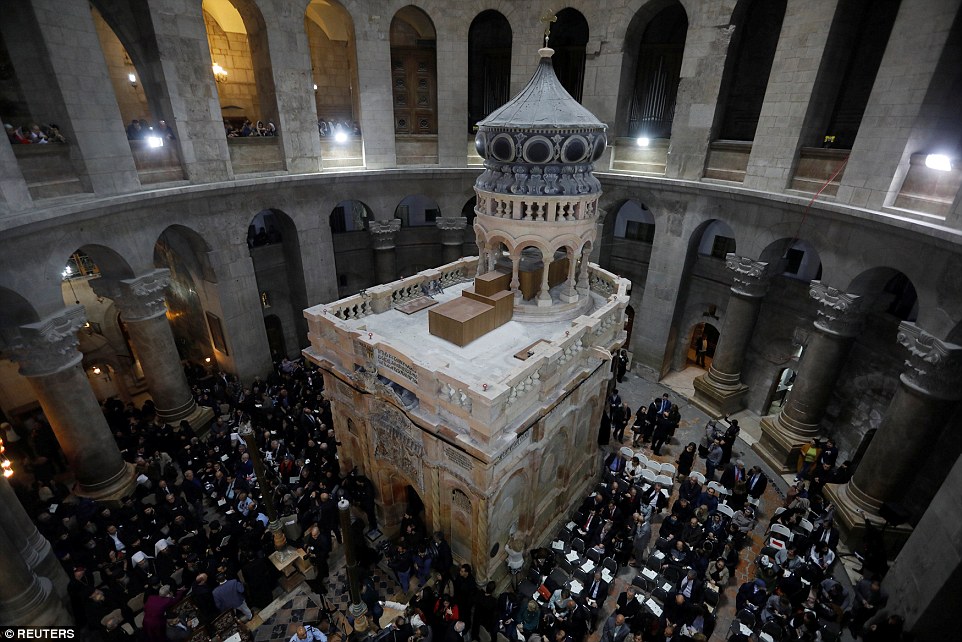Christianity’s sacred monument restored ahead of Easter
Christians all over the world celebrate Good Friday and Easter to commemorate the crucifixion, death and resurrection of Jesus Christ. Anointed and buried in a new tomb by Joseph of Arimathea after the Romans crucified him on the cross, Christians believe that God raised Jesus from the dead and that he appeared to many people over a span of forty days before he ascended into heaven.The resurrection of Jesus is the most central tenet of Christianity and the tomb where he was buried is one of its most sacred monuments on earth.
As St. Paul writes in his first Letter to the Corinthians, “For if the dead are not raised, neither has Christ been raised. And if Christ has not been raised, then your faith is a delusion and you are still lost in your sins.” This article will focus on the tomb of Jesus and the recently concluded restoration work carried inside the Church of the Holy Sepulchre in Jerusalem’s Old City. The church is home to many of Christianity’s sacred sites and includes the final stations of Via Dolorosa or the path that Jesus walked before his humiliating death, Calvary where he was crucified and the tomb where he was buried. In his article St. Helena and the True Cross, Fr. William Saunders informs us that St. Helena, mother of Emperor Constantine (reign A.D. 306- 337),“went to Palestine in search of the sacred sites about the year 324.” The earlier Roman Emperor Hadrian (reign A.D. 117-138), in an attempt to eradicate the influence of Christianity, had levelled the top of Mount Calvary and the hillside where Jesus’ tomb stood and built a temple to the pagan god Jupiter Capitolinus. Ironic as it may appear, this destruction actually preserved the sacred sites in the process.
In the following years after St. Helena’s visit, the temple of Jupiter Capitolinus was demolished and during excavation, the workers “discovered the remains of the tomb that was reported to be that of our Lord Jesus.” A new shrine was built over the tomb, which according to Fr. Saunders, has been modified over the centuries, and today stands in the Church of the Holy Sepulchre. The shrine known as the Edicule (from the Latin aedicule, or “little house”)was most recently rebuilt in 1810, two years after it was ravaged by fire. The structure had been held in place for almost 70 years by iron girders erected in 1947 on the instructions of a British governor who ruled Palestine in the Mandate era. Six denominations – Latin (Roman Catholic), Greek Orthodox, Armenian Apostolic, Syrian Orthodox, Ethiopian Orthodox and Copts – share custodianship of the cavernous church. Bitter disputes over territories and responsibilities have erupted in the past between them, sometimes involving physical altercations – and the keys to the church have been held by a Muslim family since the 12th century.
Although disputes and distrust had become a major stumbling block in restoration work for decades, they decided to bury their differences when they realized that the monument was in imminent danger of collapse. Water damage had caused it to buckle and it threatened to cave in under its own weight. In 2015, Israel’s Antiquities Authority had deemed the site unsafe and the police, amidst much protest, had briefly shut down the building. The restoration of the Edicule, undertaken by a team of Greek conservationists from the National Technical University of Athens, began in earnest after the 4 million dollar project received a philanthropic gift of 1.3 million dollars from Mica Ertegun, the widow of Atlantic Records co-founder Ahmet Ertegun, besides generous contributions from King Abdullah of Jordan, Palestinian President Mahmoud Abbas and the six denominations. A team of about 50 experts worked for nine months, mostly in the night, and used radar, laser scanners and drones in their conservation efforts.
According to a report in The Guardian, “last year in October, a marble slab covering the rock-carved tomb was lifted for the first time in more than two centuries, allowing restoration workers to examine the original rock shelf or “burial bed” on which Jesus’s body is thought to have rested. A small window has been cut into marble slabs to allow pilgrims a glimpse of the rock.”
On March 22, last month, the restored tomb was officially unveiled in the presence of Orthodox Patriarch of Constantinople Bartholomew I and other spiritual heads and dignitaries. Pope Francis was represented by the Vatican’s representative to Israel and Palestine, Archbishop Giuseppe Lazzarotto.
“For the first time in over two centuries, this sacred Edicule has been restored,” said the Greek Orthodox Patriarch, Theophilos III of Jerusalem, when the shrine reopened to the public. “This is not only a gift to our holy land, but to the whole world.”
WALTER MENEZES



























